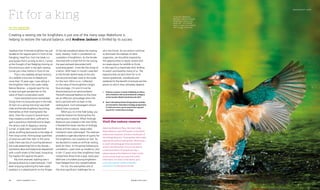More Related Content
Similar to Fit for a king - kingfisher
Similar to Fit for a king - kingfisher (20)
More from andy jackson (6)
Fit for a king - kingfisher
- 1. Fit for a king
Creating a nesting site for kingfishers is just one of the many ways Wakehurst is
helping to restore the natural balance, and Andrew Jackson is thrilled by its success
Swallow that! A female kingfisher has just
landed on her regular perch in front of me.
Dangling, head first, from her beak is a
young pike that is as long as she is. I wince
at the thought of her fledgling choking on
this enormous catch in the dark nesting
tunnel just a few metres in front of me.
That is the indelibly etched memory
of a wildlife encounter at Wakehurst
more than 15 years ago. I was sitting in
the kingfisher hide in the Loder Valley
Nature Reserve – a regular spot for me
to relax and gain perspective on the
value of Kew’s conservation work.
I have witnessed some remarkable
things from my favourite spot in the hide.
At 5am on a spring morning I saw both
male and female kingfishers launching
themselves at their nesting bank like
darts. Over the course of several hours
they created a small dent, sufficient to
gain a precarious foothold and to begin
the serious task of digging a nesting
tunnel. A week later I watched both
adults shuffling backwards to the edge of
their long tunnel, flicking large quantities
of sand out with their feet. In the same
week there was lots of courting behaviour:
the male presenting fish to the female –
sometimes alive and ready to be dispatched
with a swift shake of the head, thwacking
the hapless fish against the perch.
My most dramatic sighting was a
plunging attack by a sparrowhawk. I had
been enjoying watching this keen-eyed
predator in a relaxed perch on the fringes
of the oak woodland above the nesting
bank. Naively, I hadn’t considered it as
a predator of kingfishers. As the female
returned with a small fish for her young,
the sparrowhawk descended with
surprising speed – more like the stoop of
a falcon. With heart in mouth I watched
as the female darted away at the very
last second and kept close to the water
for the next 100m or so. I reflected
on the value of the kingfisher’s bright
blue plumage. I’m sure it must be
disorientating to an aerial predator.
The buff-coloured feathers on the chest
are an effective camouflage when the
bird is perched with its back to the
nesting bank. Such extravagant colours
clearly have a purpose.
When you sit in the hide today, you
could be fooled into thinking that the
nesting area is natural. When Ardingly
Reservoir was created in the mid-1970s,
it flooded the lower reaches of Ardingly
Brook and the natural, steep-sided
riverbanks were submerged. The reservoir
provided a super-abundance of quarry for
the kingfishers, but nowhere to nest. So
we decided to create an artificial nesting
bank for them. In the spring following its
completion, a pair took up residence, and
in the 17 years since then kingfishers have
nested here three times a year, every year.
Well over a hundred young kingfishers
have fledged from this created habitat.
For me, this exemplifies one of
the most significant challenges for us
all in the future. As our actions continue
to dominate the habitats of other
organisms, we should be inspired by
the opportunities to repair, restore and
re-create places for wildlife to thrive.
In this case it’s a charismatic bird, thrilling
to watch and loved by many of us. The
opportunities are also there for us to
restore grasslands, woodlands and
wetlands for the benefit of animals and the
plants on which they ultimately depend.
–– Andrew Jackson is head of Wakehurst Place
and a finalist in the environmental category
of the Garden Media Guild Awards 2011
»» Kew’s Breathing Planet Programme includes
an innovative restoration ecology programme.
To find out more, go to www.kew.org and
search for ‘restoration ecology’
IN THE GARDENS
Visit the nature reserve
Adjoining Wakehurst Place, the Loder Valley
Nature Reserve covers 60 hectares of woodland,
wetland and meadows, and also includes part of
the Ardingly Reservoir. The kingfisher hide is sited
opposite the artificial nesting bank, allowing you
to watch and photograph these elusive birds
without disturbing them. Entry to the reserve
is free but limited to 50 people each day –
please enquire at the Wakehurst Visitor Centre
on your arrival to get your pass and further
information. For more on the reserve, go to
www.kew.org/visit-wakehurst/garden-
attractions-A-Z and click on the link.
To tell the difference
between male and female
kingfishers, look at the
lower bill – it’s entirely
black in males but marked
with orange in females
59W W W. K E W. O R G
W A K E H U R S T V I E W
K E W S U M M E R 2 0 1 258
Photo:JoePetersburger©NationalGeographicImageCollection/Alamy
